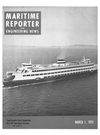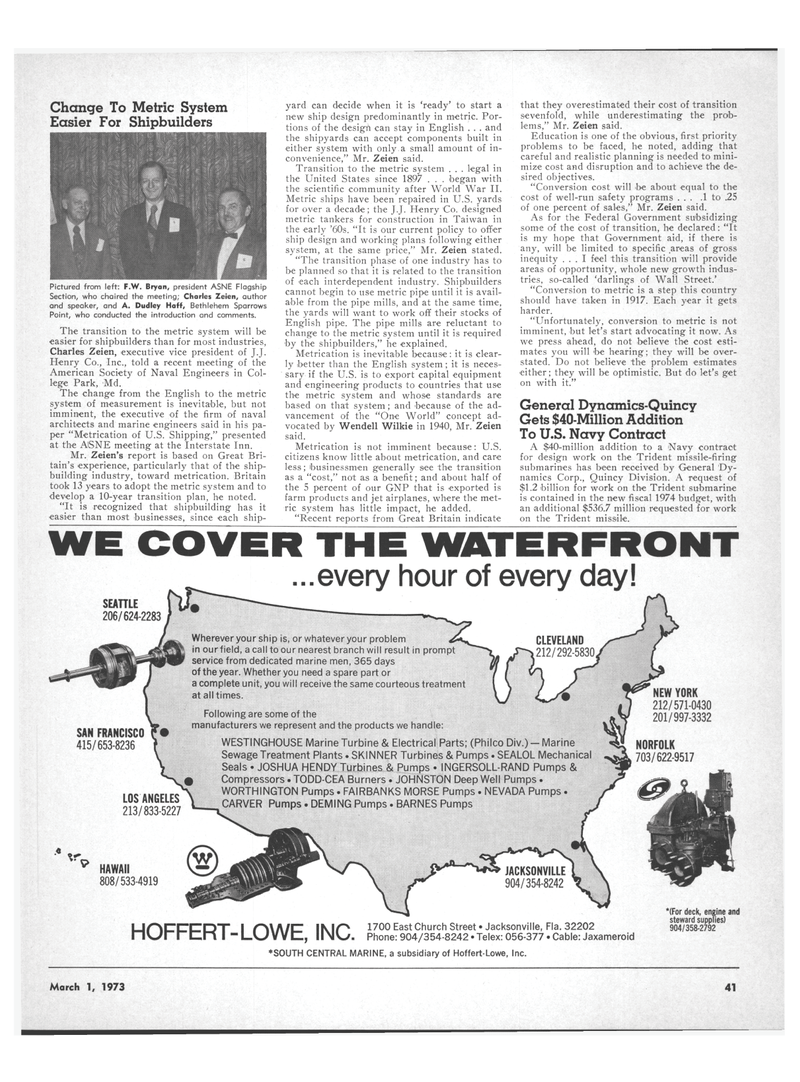
Page 33: of Maritime Reporter Magazine (March 1973)
Read this page in Pdf, Flash or Html5 edition of March 1973 Maritime Reporter Magazine
Change To Metric System
Easier For Shipbuilders
Pictured from left: F.W. Bryan, president ASNE Flagship
Section, who chaired the meeting; Charles Zeien, author and speaker, and A. Dudley Haff, Bethlehem Sparrows
Point, who conducted the introduction and comments.
The transition to the metric system will be easier for shipbuilders than for most industries,
Charles Zeien, executive vice president of J J.
Henry Co., Inc., told a recent meeting of the
American Society of Naval Engineers in Col- lege Park, Md.
The change from the English to the metric system of measurement is inevitable, but not imminent, the executive of the firm of naval architects and marine engineers said in his pa- per "Metrication of U.S. Shipping," presented at the ASNE meeting at the Interstate Inn.
Mr. Zeien's report is based on Great Bri- tain's experience, particularly that of the ship- building industry, toward metrication. Britain took 13 years to adopt the metric system and to develop a 10-year transition plan, he noted. "It is recognized that shipbuilding has it easier than most businesses, since each ship- yard can decide when it is 'ready' to start a new ship design predominantly in metric. Por- tions of the desigft can stay in English . . . and the shipyards can accept components built in either system with only, a small amount of in- convenience," Mr. Zeien said.
Transition to the metric system . . . legal in the United States since 1897 . . . began with the scientific community after World War II.
Metric ships have been repaired in U.S. yards for over a decade; the J.J. Henry Co. designed metric tankers for construction in Taiwan in the early '60s. "It is our current policy to offer ship design and working plans following either system, at the same price," Mr. Zeien stated. "The transition phase of one industry has to be planned so that it is related to the transition of each interdependent industry. Shipbuilders cannot begin to use metric pipe until it is avail- able from the pipe mills, and at the same time, the yards will want to work off their stocks of
English pipe. The pipe mills are reluctant to change to the metric system until it is required by the shipbuilders," he explained.
Metrication is inevitable because: it is clear- ly better than the English system; it is neces- sary if the U.S. is to export capital equipment and engineering products to countries that use the metric system and whose standards are based on that system; and because of the ad- vancement of the "One World" concept ad- vocated by Wendell Wilkie in 1940, Mr. Zeien said.
Metrication is not imminent because: U.S. citizens know little about metrication, and care less; businessmen generally see the transition as a "cost," not as a benefit; and about half of the 5 percent of our GNP that is exported is farm products and jet airplanes, where the met- ric system has little impact, he added. "Recent reports from Great Britain indicate that they overestimated their cost of transition sevenfold, while underestimating the prob- lems," Mr. Zeien said.
Education is one of the obvious, first priority problems to be faced, he noted, adding that careful and realistic planning is needed to mini- mize cost and disruption and to achieve the de- sired objectives. "Conversion cost will be about equal to the cost of well-run safety programs ... .1 to .25 of one percent of sales," Mr. Zeien said.
As for the Federal Government subsidizing some of the cost of transition, he declared: "It is my hope that Government aid, if there is any, will be limited to specific areas of gross inequity ... I feel this transition will provide areas of opportunity, whole new growth indus- tries, so-called 'darlings of Wall Street.' "Conversion to metric is a step this country should have taken in 1917. Each year it gets harder. "Unfortunately, conversion to metric is not imminent, but let's start advocating it now. As we press ahead, do not .believe the cost esti- mates you will be hearing; they will be over- stated. Do not believe the problem estimates either; they will be optimistic. But do let's get on with it."
General Dynamics-Quincy
Gets $40-Million Addition
To U.S. Navy Contract
A $40-million addition to a Navy contract for design work on the Trident missile-firing submarines has been received by General Dy- namics Corp., Quincy Division. A request of $1.2 billion for work on the Trident submarine is contained in the new fiscal 1974 budget, with an additional $536.7 million requested for work on the Trident missile.
WE COVER THE WATERFRONT ...every hour of every day!
SEATTLE 206/624-2283
SAN FRANCISCO 415/653-8236
LOS ANGELES 213/833-5227
Wherever your ship is, or whatever your problem CLEVELAND in ourfield, a call to our nearest branch will result in prompt r—v 212/292-5830 service from dedicated marine men, 365 days of the year. Whether you need a spare part or a complete unit, you will receive the same courteous treatment at all times.
Following are some of the manufacturers we represent and the products we handle:
WESTINGHOUSE Marine Turbine & Electrical Parts; (Philco Div.) - Marine
Sewage Treatment Plants. SKINNER Turbines & Pumps. SEALOL Mechanical
Seals • JOSHUA HENDY Turbines & Pumps • INGERSOLL-RAND Pumps &
Compressors. TODD-CEA Burners. JOHNSTON Deep Well Pumps.
WORTHINGTON Pumps. FAIRBANKS MORSE Pumps . NEVADA Pumps.
CARVER Pumps. DEMING Pumps. BARNES Pumps
NEW YORK 212/571-0430 201/997-3332
NORFOLK 703/622-9517
HAWAII 808/533-4919 m i pk JACKSONVILLE 904/354-8242
HOFFERT-LOWE, INC. 1700 East Church Street • Jacksonville, Fla. 32202 Phone: 904/354-8242 • Telex: 056-377 • Cable: Jaxameroid *(For deck, engine and steward supplies) 904/358-2792 * SOUTH CENTRAL MARINE, a subsidiary of Hoffert-Lowe, Inc.
March 1, 1973 41

 32
32

 34
34
